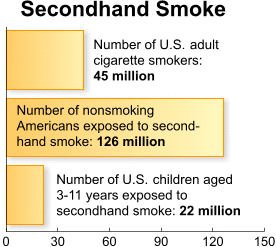Smoke-Free Policy
The
impact that cigarette smoking has on nonsmokers is possibly even more
devastating than on smokers because nonsmoking individuals typically do not choose to
be exposed to secondhand smoke. The toxic chemicals that the smoke
contains can remain in the air for hours, which provides ample
opportunity for exposure (Mayo, 2012). One of the arguments against
smoke-free policies is that nonsmokers are only exposed to ETS for
the short time that they are in the bar or restaurant, so they should
not experience any effects. However, the 2006 Surgeon General's
Report stated that there is no safe level of exposure to tobacco
smoke, and that even short-term exposure can potentially increase a
person's risk for disease (ALA, 2013). This includes an increase of
20-30% for the risk of developing lung cancer (Texas Oncology, 2013).
There are also many other significant effects. 50,000 nonsmoking
adults die as a result of secondhand smoke exposure each year, the
majority from lung cancer and heart disease (Texas Oncology, 2013).
Children are also at risk for exposure and its consequences. 53.6% of
children were exposed to secondhand smoke from 2007-2008 (“Secondhand
smoke facts,” 2013) This is of particular concern for children who
suffer from asthma. 400,000-1,000,000 children experience an
aggravation of asthma every year as a result of ETS (ALA, 2013).
Another form of exposure that is common among children is “thirdhand”
smoke. This involves children coming into contact with the residue
that remains on hair, clothing, and other surfaces after cigarettes
are smoked and then ingesting that residue (Mayo, 2012). The dangers
of secondhand smoke pose such a significant threat to the health of
people of all ages that individuals who choose not to smoke
cigarettes should not be exposed in public locations that are shared
by all people.

The
best possible way to prevent exposure to secondhand smoke is to
eliminate smoking in public by creating and implementing smoke-free
policies. According to the CDC, eliminating cigarette smoking in
indoor areas is the only way that nonsmokers can be entirely
protected from ETS (“Secondhand smoke facts,” 2013). Separating
smokers and nonsmokers, cleaning the air, opening windows, and
ventilation do not eliminate secondhand smoke, and nonsmokers will
still be exposed to ETS (“Secondhand smoke facts,” 2013).
Twenty-nine states currently have comprehensive smoking bans in
place, and they have demonstrated success on a number of different
levels (Texas Oncology, 2013). A key concern for many when a
smoke-free policy is proposed is that it will not be supported by the
public and facilities will not comply with the policy, but the
opposite has been shown to occur. Prior to the implementation of a
statewide smoke-free law in New York in 2003, only 31% of facilities
were smoke-free, but that number increased to 93% within one month
and 97% within one year (“Smoke-free policies result,” 2011).
Support for the law also increased during the first two years among
nonsmokers from 74% to 86% and from 25% to 37% among smokers
(“Smoke-free policies receive,” 2011). Another common argument is
that a smoking ban will result in a loss of business for bars and
restaurants. However, a study of multiple states with smoke-free laws
determined that restaurants experienced no change in sales
(“Smoke-free policies do,” 2012). A second study revealed that
the city of Pueblo, Colorado experienced a 20.3% increase in sales
tax revenue from bars and restaurants after a smoking ban was
implemented (“Smoke-free policies do,” 2012). In addition,
smoking bans have been associated with improved health outcomes among
nonsmoking bar and restaurant workers in studies conducted in
Scotland, Ireland, and California, including improved lung function
and reduced respiratory symptoms (“Smoke-free policies improve,”
2011). An association was also shown between the implementation of
these smoking bans and a reduction in hospital admissions for heart
attacks (“Smoke-free policies improve,” 2011). Implementing and
enforcing smoke-free policies is the only way to prevent secondhand
smoke exposure in public places, and it can be done without
significant negative consequences.
References
American
Lung Association. (2013). Secondhand
smoke.
Retrieved from
http://www.lung.org/stop-
smoking/about-smoking/health-effects/secondhand-smoke.html
Centers
for Disease Control and Prevention. (2007, June 14). Secondhand
smoke.
Retrieved from
http://www.cdc.gov/datastatistics/archive/second-hand-smoke.html
Centers
for Disease Control and Prevention. (2013, June 10). Secondhand
smoke facts.
Retrieved from
http://www.cdc.gov/tobacco/data_statistics/fact_sheets/secondhand_smoke/general_facts/
Centers
for Disease Control and Prevention. (2012, February 6). Smoke-free
policies do not hurt the
hospitality industry.
Retrieved from
http://www.cdc.gov/tobacco/data_statistics/fact_sheets/
secondhand_smoke/protection/hospitality/index.htm
Centers
for Disease Control and Prevention. (2011, March 11). Smoke-free
policies improve health.
Retrieved from
http://www.cdc.gov/tobacco/data_statistics/fact_sheets/
secondhand_smoke/protection/improve_health/
Centers
for Disease Control and Prevention. (2011, March 9). Smoke-free
policies receive public
support.
Retrieved from
http://www.cdc.gov/tobacco/data_statistics/fact_sheets/
secondhand_smoke/protection/public_support/index.htm
Centers
for Disease Control and Prevention. (2011, March 9). Smoke-free
policies result in high levels
of
compliance.
Retrieved from
http://www.cdc.gov/tobacco/data_statistics/fact_sheets/
secondhand_smoke/protection/compliance/index.htm
Mayo
Clinic. (2012, March 20). Secondhand
smoke: Avoid dangers in the air.
Retrieved from
http://www.mayoclinic.com/health/secondhand-smoke/CC00023
Texas
Oncology. (2013). Smoking
bans.
Retrieved from
http://www.texasoncology.com/media-
center/fact-sheets/smoking-bans.aspx

1 Comments:
I really like the large amount of facts in this post. The graph gives a great idea of the number of people exposed to second-hand smoke!
Post a Comment
Subscribe to Post Comments [Atom]
<< Home